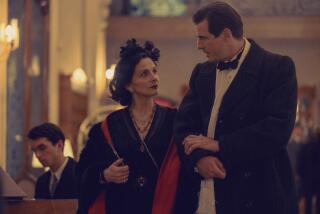Mystery, lover, agent provocateur
- Share via
“She was undoubtedly one of the exceptional women of her time -- a time that showed no mercy or pity toward her or her generation. That generation, born between 1890 and 1900, was almost completely destroyed by war, revolution, emigration, the camps, and the terror of the 1930s.... But she didn’t cling to her sweet and false past, didn’t play the helpless parasite, didn’t hide from the challenges fate handed her, and she didn’t claim ‘female weakness’ to try to justify the mistakes she made.”
So Nina Berberova characterizes Moura Budberg, a “mystery woman” if ever there was one. Variously suspected of spying for the Germans during World War I, for the British in the ill-fated Lockhart affair of 1918-19 (a conspiracy that almost brought down the fledgling Soviet Union) and for the Soviets much of the rest of the time, Moura was also immensely alluring to men. Her romance with British agent Robert Bruce Lockhart was recounted by him in his enormously successful memoir “British Agent,” the basis for the colorful 1934 film of that title.
Moura’s vitality, intelligence and charm made her indispensable to Maxim Gorky, who declared: “[S]he knows everything and is interested in everything.” Her long liaison with H.G. Wells seems to have provided the aging, increasingly querulous author with a sense of sympathy and comfort.
Born in 1892 into an upper-class Russian family, Moura spent time in England before the war, hobnobbing with diplomats, aristocrats, writers and celebrities, including two who would later play a larger role in her life: Wells and Lockhart. There she also met Ivan Benckendorff, a diplomat, whom she wed in 1911.
In the wake of the Bolshevik Revolution, Benckendorff was clubbed to death by peasants from a village near his family’s Estonian estate. The couple’s two children managed to escape with their English governess, while Moura had the good fortune to be in Petrograd -- as St. Petersburg was known then.
Moura came by the name Budberg and the title of baroness in 1922, when she wed Baron Nikolai Budberg, a down-and-out Estonian aristocrat, in what Berberova describes as a marriage of mutual convenience. Moura, who’d just fled Russia, gained a title and Estonian citizenship; it’s less clear, from this account, exactly what was in it for him. All this time, Moura was Gorky’s mistress and a pivotal member of his household, working as his secretary, translator and literary agent. It was to Moura that he entrusted his papers when he returned from Europe to Russia, fearing what might happen were they to fall into Stalin’s hands, which, alas, they did.
Although Berberova does not state unequivocally that Moura was a Soviet agent, the inference seems clear enough.
Berberova, who fled Russia in 1922, lived for three years under the same roof with Moura in the Gorky household. Although she never became an intimate of the wily enchantress, she was in a good position to observe her: “Her energy, her vitality, her desperate instinct for survival were all things I could feel and understand....” But Berberova was troubled by her caginess: “She was a hawk. A leopard. And I had met her not so that I could emulate her but so that, by watching her, I could survive in my own way, a different way, becoming neither a hawk nor a leopard.”
Berberova, who died in 1993 at age 92, recounted her life story in a memorable book published in 1992: “The Italics Are Mine.” She began work on Moura’s biography in the late 1970s, and it was first published in Russian in 1981. The book did not find a British or American publisher until now, although Marian Schwartz and Richard D. Sylvester embarked on their English translation in 1980. The Russian version, they inform us, is longer, containing more historical background previously unknown to Russian readers but familiar to Westerners.
Like its subject, “Moura” is hard to categorize: It is less a close-up of the secretive Budberg than a kaleidoscopic look at the world in which she lived. Berberova brings to life not only Moura’s lovers, but also a host of other people, many of whom she knew personally, who were caught up in the turmoil and betrayals of those years. In a way, the unsung heroine of “Moura” is Berberova herself, combing through archives and memories and serving as the prism though which history is refracted.
Merle Rubin is a contributing writer to Book Review.
More to Read
Sign up for our Book Club newsletter
Get the latest news, events and more from the Los Angeles Times Book Club, and help us get L.A. reading and talking.
You may occasionally receive promotional content from the Los Angeles Times.










